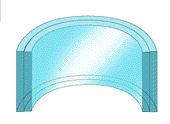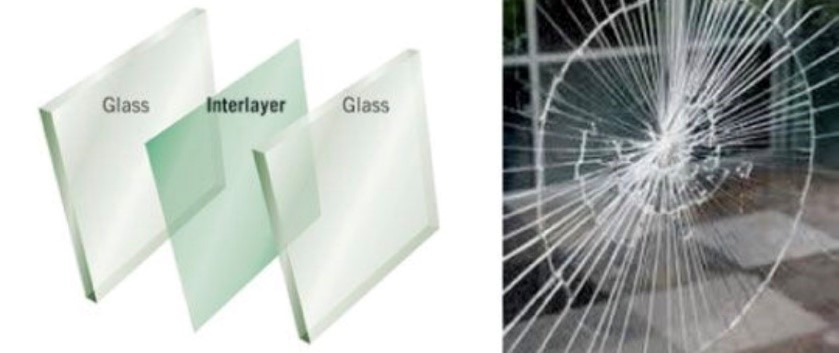Laminated Glass Basics

Laminated glass consists of two pieces of glass bonded together by a plastic interlayer. Unlike other forms of monolithic glass, glass fragments are retained after breakage. This post-breakage condition enables laminates to provide safety in the case of accidental impact, minimizing cutting and/or piercing injuries. Laminated glass interlayers include polyvinyl butyral (PVB), ionoplast, polyurethane (PU), ethylene vinyl acetate (EVA), and cast-in-place resins.

Laminated Safety Glass Manufacturing
Laminated glass is typically made via an assembly line process that is followed by controlled exposure to heat and pressure in an autoclave. Curved laminates are assembled and then encased in vacuum bagging prior to autoclaving. The process for making cast-in-place resin laminates varies based on the resin. For instance, a laminate may require exposure to UV lights to fully cure. Other resin laminates may require different curing techniques.
Laminated Glass Types
All glass types can be laminated. The basic safety laminate consists of two plies of annealed glass. Some architectural and transportation applications require the glass to be heat or chemically strengthened, or tempered, for greater strength, as well as better resistance to thermal and mechanical stresses. Clear, tinted, and low-E glasses can be laminated. Laminated glass can be part of an insulating glass unit for greater mechanical and thermal performance.
Interlayer Types
Interlayers fall into two categories, flexible and stiff. Polyvinyl butyral (PVB) is an example of a flexible interlayer. Within this category, there are standard safety interlayers and those specifically designed for sound attenuation, security, and solar performance. Ionoplast interlayers are stiff interlayers—100x stiffer than standard PVB and five times more tear resistant. Besides its strength, ionoplast interlayer is less moisture sensitive, an important feature with open-edge glazing systems. It is important to confirm the compatibility of all coatings, frits, sealants that will come in direct contact with the interlayer.
Interlayer features
Most interlayers filter up to 99% ultraviolet below 380 nm. This feature enables laminates to help minimize fading of fabrics and furniture caused from UV exposure. In addition, interlayers are available in clear or tints. The tints are often used to minimize glare from excessive sunlight. Interlayers are available in a variety of thicknesses from 0.015 inch to 0.090 inch. For instance, an 0.015-inch interlayer may be used in a transportation side lite application, but 0.030 inch is required for windshields. Architectural laminates made with annealed glass for safety glazing typically incorporate a 30-mil PVB or 35-mil ionoplast interlayer. When heat-strengthened or fully tempered glass is laminated, a 60-mil interlayer is used. Skylight glazing and laminated glass railings will generally require a 60-mil interlayer. Thicker interlayers may be required for other security applications. The quality requirements for laminated architectural glass are found in ASTM C1172. This standard sets tolerances on blemishes that can occur during fabrication, including boils (bubbles), blow-ins, hair/lint, inside dirt, and short interlayer scuffs (streaks).
Performance Standards
| Standard | Type | Impact requirements | Weathering requirements | Structural |
|---|---|---|---|---|
| ANSI Z97.1 | Architectural | x | x | |
| UL 972 | Architectural (burglar) | x | ||
| UL 752 | Architectural (ballistic) | s | ||
| ASTM E1886/E1996 | Architectural (hurricane) | x | ||
| ANSI Z26.1 | Automotive | x | x | |
| FRA Part 223 | Rail | X Impact & ballistics | ||
| FAA AC 25.775.1 | Aviation | X Ultimate static strength, fatigue, fail safe |
Interlayers
PVB and ionoplast: https://www.trosifol.com

